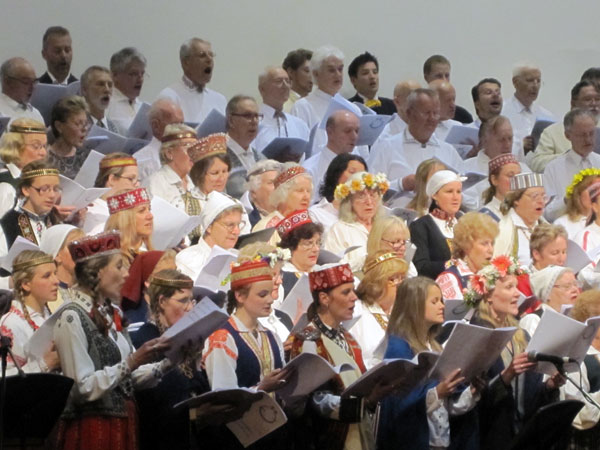
Choirs from all around Australia perform during the concert “Svētki dziesmai,” part of the 53rd Australian Latvian Arts Festival. (Photo by Daina Gross)
As the Latvian choristers filed up on stage you couldnt stop pinching yourself. It was just after Christmas, just under 30 degrees Celsius, quite pleasant for this time of year. Latvia itself was covered by a thick, woolly blanket of snow. Winter had well and truly set in, ready for the long haul.
Here in the Antipodes, summer had only just poked out its nose and the sweltering heat that will surface soon was still only a vicious rumour. It was time for the Australian Latvian Arts Festival (Austrālijas latviešu Kultūras dienas).
Up on the stage, each choir member had their own, freshly ironed, individually fitted national costume. Each costume, representing different regions of Latvia, was either lovingly handmade by its wearer or specially purchased for occasions such as this. The choir members came from the different states of Australia, yet every one carried a tiny part of Latvia.
As they continued to file onto the stage—some finding it easy to move, others needing some assistance—one wondered what each chorister was thinking as they made their way to their position. Every person had their own reason for being here. Some were born in Latvia 70-odd years ago and moved to Australia after the war. Some were descendants of the Latvian refugees. Some moved here from Latvia a year or two ago. Each individual on stage had some affiliation with Latvia—their homeland, their fatherland, the land of their forefathers. For some it could even be the homeland of their spouse.
Latvians have come to Australia at various times for different reasons over the past century. Many have blended into mainstream Australian society and have little to do with their homeland. However, there are pockets of Latvians, as well as individuals throughout Australia, who are proud of their heritage and wish to celebrate their culture. This is possible at the biennial Australian Latvian Arts Festival, held alternately in Adelaide, Melbourne and Sydney.
This festival, held Dec. 26-Jan. 1 in Melbourne, was the 53rd of its kind. In previous years festivals have also been held in Brisbane, Perth, Hobart and Canberra. Not only does the festival showcase Latvian singing and dancing, this year’s events also included an art exhibition, a theatre performance, a children’s day and market, a public lecture, two youth variety performances, and a few other meetings and events.
With dwindling numbers in the community, some people might wonder if the festival is still worthwhile or relevant. After witnessing this year’s festival you certainly get the impression that it still has a future, and not a faltering or waning one at that.
All performances were sold out. The organisers were primarily in their 40s and 50s—a changing of the guard. The organisers aimed at attracting an audience that did not necessarily need to understand Latvian for many of the events. The atmosphere was welcoming, especially during the market day, where for some Australians of Latvian descent this was their first encounter with things Latvian. The ladies auxiliary at the Latvian House took in record earnings.
The festival organisers had involved big-name local talent from the world of the arts: playwright Jānis Balodis and artist Imants Tillers, famous and popular Latvian conductors Ints Teterovskis and Agita Ikauniece, as well as the music ensemble Tango Sin Quinto from Latvia.
An innovative and brave move was a rejuvenation of the mixed choir. Choristers were truly multi-generational, from primary schoolchildren to ladies and gentlemen aged 75-plus years. This proved to the community that it is still possible to gather together local Latvians with minimal opportunities to rehearse and attain a high standard for a non-professional choir—and disproving the absolute necessity for imported choirs from Latvia.
The other new event was the extension of the choir concert after-party to a massed singalong open to everyone, much like the singalongs that have become a regular feature after the Latvian Song Festival at Mežaparks in Rīga. With such an overwhelming response to this event it would be a shame if this was not included in future Arts Festivals.
The Melbourne Latvian House had also undergone significant changes, bringing some of the tired spaces in the building into the 21st century. The transformation of the front courtyard of the house into an outdoor café and concert space was also a success, proving that every corner of the property can be utilised efficiently. The renovations to the house will be of lasting benefit to the Melbourne Latvian community for years to come.
This Arts Festival is proof that the baton has truly been passed on to the next generation—and that there is nothing to fear in this. The children of Latvian refugees, together with more recent émigrés have shown that they have the vision, talent and creativity to put together a festival to be proud of. New events as well as the sprucing up of traditional events to give them a more contemporary and emotive feel have opened up the Arts Festival to a new world of possibilities. May the committee of the next Arts Festival continue on this exciting new road!
The Australian Latvian Arts Festival in 2010 is proof of the resilience and pride of Latvians living outside Latvia the world over. With so many Latvians leaving Latvia in recent years one can only hope they end up in communities such as this, get involved, find their place and—despite the predicament they find themselves in needing to leave Latvia for economic reasons—contribute with their talents and knowledge to cherishing the Latvian spirit.
Daina Gross is editor of Latvians Online. An Australian-Latvian she is also a migration researcher at the University of Latvia, PhD from the University of Sussex, formerly a member of the board of the World Federation of Free Latvians, author and translator/ editor/ proofreader from Latvian into English of an eclectic mix of publications of different genres.




